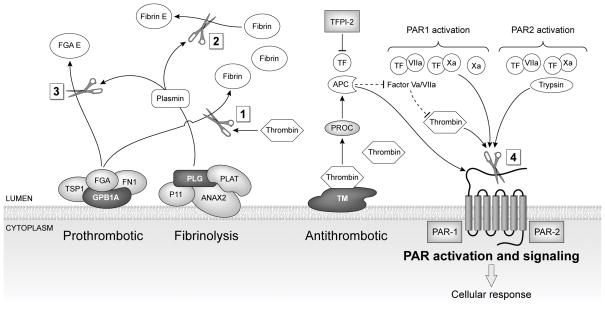Fig. 6.
NSAIDs perturbed genes related to thrombosis, fibrinolysis, and PAR signaling. Thrombin cleaves Fibrinogen (FGA) to form insoluble fibrin monomers (Box 1). Fibronectin (FN1) and thrombospondin 1 (TSP1) bind to fibrinogen, and are positive regulators of blood coagulation. Glycoprotein 1b (GP1BA) functions as a receptor for von Willebrand factor. Fibrin and fibrinogen are further degraded by plasmin (Box 2, 3). Plasmin is derived from cleavage of proenzyme plasminogen (PLG) by tissue-type plasminogen activator (PLAT). Annexin 2 (ANAX2) forms a heterotetramer with S100 family protein p11 and serves as a cofactor for plasmin generation. Tissue factor pathway inhibitor (TFPI-2) and protein C (PROC) are key components of anticoagulant pathways. Thrombin and other coagulation proteases (factor Xa, VIIa) activate protease activator receptors PAR1 or PAR2 (Box 4) which initiate G protein-mediated intracellular signaling, leading to cell type dependent pro-inflammatory or protective responses in endothelial and smooth muscle cells. Genes down-regulated by NSAIDs are shown in light gray. Genes up-regulated by NSAIDs are shown in dark gray.

